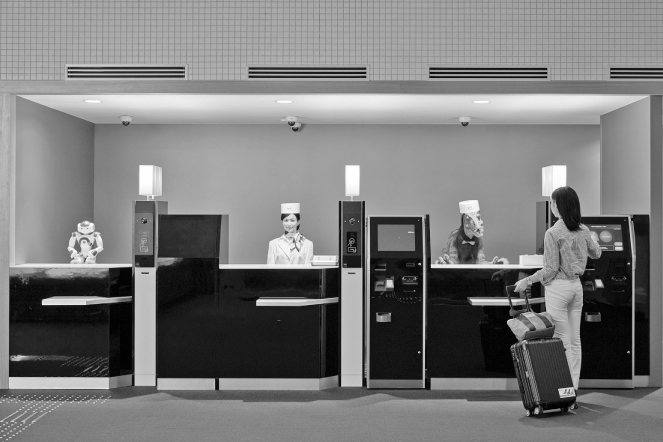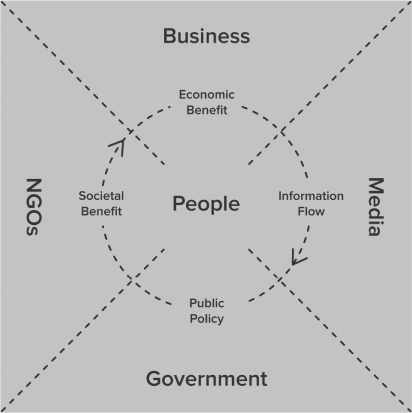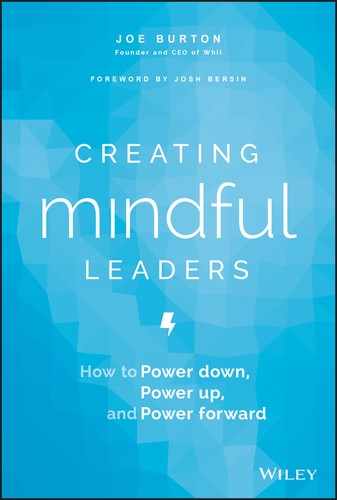
Chapter 2
What's Stressing People Out?

So now you know what mindfulness is. And you know it doesn't have to be creepy or new age‐y or spiritual. But why do you need it? Let's start with a few high‐level questions to get to know one another. Do you suffer from back pain? Insomnia? Stress? Annoying co‐workers? If you answered yes to any of these, you're in the majority of professionals having a similar life experience. Increasingly, that experience is contributing to poor health, declining performance, and toxic work cultures. We'll get to that in a moment. For now, let's dig into the details around what's stressing us all out. Then, we'll work on the antidote.
Welcome to Work
Think back to when you were being recruited for your current role. The conversation with your suitor probably went something like this: “You're going to love it here. The company is great. The CEO is brilliant. Our culture is awesome. We have our mission, vision, and values on the wall! You're going to fit right in. Look at how cool our offices are. Have I told you about the snacks? OMG, the snacks are amazing!” As a candidate, you can almost hear the birds singing and see butterflies surrounding Bambi as he prances across your new work campus. We tend to put the best face on everything when we're recruiting.
Welcome to Work, Take Two
Once you start work, the reality is a bit different. How did conversations in your first week at the new job go? “Welcome back. We forgot to mention that the pace of business is relentless. Ongoing change and disruption is the norm. On any given day, you'll be dealing with globalization, innovation, and transformation. Actually, we're dealing with all the ‐ations. Expectations and inundation may lead to frustration, speculation, and aggravation. But we still expect you to be amazing! The table stakes are high. And there's a lot of confusion and concern with robotics and artificial intelligence. Have fun! You'll be great.”
The truth is: work is hard. Every now and then there's a forest fire and sometimes Bambi's mom gets shot. Oh, and we're out of snacks. Are you equipped to deal?
Are You Sending Mixed Messages?
We need leaders to help avoid mixed messages in the business world. Most companies tell employees, “You are our most important asset!” But what happens next? According to The Economist, 90% of companies cite offshoring as crucial to their growth and to reduce costs.1 In 2013, 43% of the global IT sector had been outsourced. Today, it's 72%.2 So, “We love you, but we love less expensive employees more.” The rapid changing nature of global economics also has offshoring changing to “nearshoring” and sometimes to “backshoring.” We love you. We love you not. Oops, we love you again.
More companies are acquiring companies as their de facto innovation strategy. Or worse, they outsource innovation to third parties because they can't keep pace with change. Once again, a mixed message. We love you, but we're giving a lot of the cool work to other folks. My bad. You understand.
The Future Is Now
Our fascination with robotics has moved from The Jetsons to being real, son. We used to think about robots as big mechanical arms helping to build cars. Now, self‐driving cars are paving the way for self‐driving trucks. Machines are already asking, “Do you want fries with that?” Throughout Asia, hotels are replacing their desk clerks with robots (Figure 2.2).3 You have your choice of checking in with an attractive lifelike female robot, a T‐Rex robot, or a super‐cute kid's toy robot. Drones will go from delivering our packages to delivering our persons. For anyone familiar with commercial aircraft, you know planes already are robots. Pilots are there for taking off and landing. Everything else has been automated for decades. The World Economic Forum estimates that some five million jobs will be replaced by technology by 2020.4 That estimate goes up as much as threefold depending on which futurist you believe.

Figure 2.2 Robot desk clerks in Japan
Source: Permission courtesy of © Huiten Bosch
Not Even Pizza Is Safe. In September 2017, Ford and Domino's announced a partnership for self‐driving cars to deliver pizzas. Not to be outdone, Little Caesars announced their robotic “Pizza Portal”: You text and the robot makes your pizza. Employees have ongoing low‐level concerns about robotics and AI usurping their jobs. But when you start messing with their pizza, sh*t just got real. The future is now and it's freaking people out. Employees are asking, “What's going on? Does the company have a plan? Why isn't anyone talking to us? Should I be looking for my next job?” And sites like LinkedIn and Glassdoor are in business to feed those fears. If you don't believe me, join your collaboration channels at work. These conversations are consuming employee time. Right. Now.
Coopetition Is Temporary. Does your company have any competitors that you also partner with? For most companies, “coopetition” has become the norm. For anyone who has simultaneously partnered and competed, you know the endgame is generally to partner until you can cut your partner out of the picture. Language within the company reflects that, and that sends mixed messages to your employees about how the company does business. If you don't think so, ask the millennials on your team. Coopetition is the new game.
Procurement Don't Play. Procurement moved from being the redheaded stepchild 20 years ago to now having a seat on the board. Their job is to cut 10% to 15% of costs every year, relegating many of your most trusted business partners into your cheapest vendors. That changes how vendors service your company and increases stress for employees who rely on them. When I was the global COO of a $2 billion agency network, we ran a procurement playbook to maximize productivity and reduce costs. Our clients ran the same playbook on us. Wait, what? That's a double whammy when it comes to disruption.
“Faster and Cheaper” procurement decisions can even alter the culture. When I was the head of financial planning at the CBS Television Network, a “cheap” deal to buy a near‐bankrupt beauty pageants company in partnership with Donald Trump, resulted in low‐cost programing. Sadly, in my opinion, it also resulted in ongoing chatter about sexual harassment claims, needless lawsuits, a decreased regard for the “Tiffany Network,” and unnecessary stress and low morale for CBS employees. Cheap filler programming that cost us $10 million for a 50% share in a tiny joint venture became a growing distraction to the Network's other $4.5 billion in annual revenue.
Tech Espionage Is Ramping. The Justice Department estimates that the United States has already lost over two million jobs and hundreds of billions in technology revenue to China.5 Russia hacked the 2016 U.S. election. For at least two major governments, hacking and espionage has turned into the lucrative business of stealing technology, designs, products, and data and selling them back to the country of origin at a lower cost. Let alone other political efforts to sow confusion and division. The undercurrent of anxiety related to both job security and national security is rising.
The Cool Stuff Is Being Outsourced. There are now nearly seven million people working in technology research.6 This isn't the Genius Bar at your local Apple store. We're talking about deep technology research. For more companies, the rate of innovation outstrips their ability to manage it in‐house. As Gary Hamel wrote in his book, What Matters Now, “The world is becoming more turbulent faster than most organizations are becoming more resilient.”7
And Life Is Hard. On top of all of this, employees have a rising undercurrent of disruption before they even get to work. We're now dealing with global warming and unprecedented destruction from natural disasters. Healthcare, Medicaid, taxes and privacy seem in constant flux. Terrorism has become a norm. Politics have moved to the extreme in developed countries. Some countries are even being run by incompetent egomaniacs and their crazy family members. Thank goodness that could never happen in the United States.
Equifax's hacking created uncertainty for 143 million Americans, including me, who are now facing a serious threat of identity theft for the rest of our lives. Not to be outdone, Yahoo! exposed three billion users and failed to disclose it for three years. Since 2006, sixteen major companies exposed nearly 5 billion consumer records, with many forgetting to mention it until being caught.
At home, many of us parents are dealing with stressed‐out children. So, domestic terrorism is in the hizzouse.
Given all we have going on before we even get to work, it's no surprise that it's not turning out great. More employees are feeling that events are out of their control, there's a lack of trust or there's constant exposure to the latest calamity. A lack of job security has put a low‐grade, chronic stress response on simmer. When you add in work stressors, the expectation that employees will trust in management or just figure it all out is no longer a sustainable strategy.
It's a great time opportunity for leaders to step in to help, listen, and lead through the issues.
Employees Are Sharing More and Trusting Less
The rise of the sharing economy has us opening up and trusting folks in ways that would've been hard to imagine a few years ago. We trust strangers to drive us around (Uber), deliver our food (Seamless), rent our homes (Airbnb), babysit our kids (care.com), and our pets (dogvacay.com). You can even borrow luxury cars (RelayRide). Kids. Dogs. Cars. Oh, my! The trust and flexibility in these new models requires participants to suspend fear and judgment.
With all the mixed messages, research suggests that the sharing economy is carrying over to employees sharing more with each other about the workplace on external sites (GlassDoor) and internal collaboration tools (Slack, Yammer, and others). But sadly, without the trust factor or willingness to suspend fear and judgment about management.
The 2017 Edelman Trust Barometer revealed a “crisis in trust” with the largest‐ever drop reported across all major institutions. Specifically, a minority of people now trust the media (43%), government (41%), CEOs (37%), and political leaders (29%).8 The study of 33,000 respondents showed the largest gap ever between the 13% of respondents considered “informed” (college educated, top 25% of earners, with significant media consumption) versus the 87% global mass population considered “not informed.” The majority of the mass population now mistrusts all four major institutions in 20 of the 28 largest countries.
When the subject comes to trust, employees would overwhelmingly rather hear from other employees over senior management or CEOs. Respondents ranked fellow employees more credible than senior management to share news on culture and treatment of employees by a factor of 2.5 times higher. The same was true for sharing financial results (1.7 times), handling a crisis (1.6 times), and to a lesser degree innovation (1.3 times), understanding industry drivers (1.2 times), and programs addressing societal issues (1.2 times). CEOs fared even worse across the board.
This distrust results in four key themes where leaders with the right approach can make all the difference:
| 1. Sense of injustice 2. Lack of hope | 3. Lack of confidence 4. Desire for change |
The report uncovered major trust issues, especially for business:
Change in the Mass Population Landscape:
| Feeling that business is stoking societal fears with:
|
There's a clear movement toward employees wanting leaders to speak with them, not at them. They prefer spontaneous to rehearsed (57%), blunt to diplomatic (54%), and personal experience over data (51%). The mass population also looks more to social media than to advertising (62%) for influence. The old model isn't working. The new model is breaking. It's time for an operating model, with the people, that is mindful of the times (Figure 2.3).

Figure 2.3 Are you making the shift fast enough?
Source: 2017 Edelman Trust Barometer, used with permission of Edelman.
Conversations about these concerns occur in your company daily, openly or in private collaboration channels. While this movement away from “for the people” to “with the people” may feel scary, the time is perfect for leaders trained in mindfulness and emotional intelligence to place people at the center to change the future (Figure 2.4).

Figure 2.4 “With the People” puts employees at the center.
Source: 2017 Edelman Trust Barometer, used with permission of Edelman.
